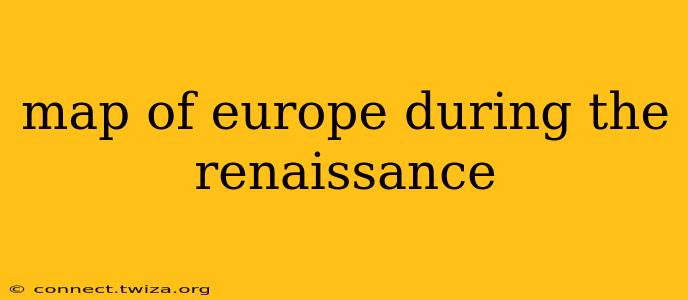The Renaissance, a period of immense cultural and intellectual flourishing, spanned roughly from the 14th to the 17th centuries. Understanding the map of Europe during this era is crucial to grasping the complex interplay of political power, artistic movements, and intellectual exchange that defined the time. It wasn't a static picture; borders shifted, alliances formed and dissolved, and the balance of power constantly fluctuated. This exploration will delve into the major political entities, key geographic features, and the significant shifts that shaped the map of Renaissance Europe.
The Major Players: Political Entities of Renaissance Europe
The map of Renaissance Europe wasn't simply a collection of neatly defined nations as we know them today. Instead, it was a patchwork of kingdoms, duchies, republics, and empires, often embroiled in conflict and competition. Some of the key players included:
-
The Holy Roman Empire: A vast, sprawling entity encompassing much of Central Europe, the Holy Roman Empire was a complex political structure composed of numerous independent principalities and free imperial cities. Its power was often challenged by its constituent parts, leading to internal conflicts and struggles for dominance.
-
France: A major power throughout the Renaissance, France underwent periods of both consolidation and conflict under various monarchs. The expansion of royal authority and the burgeoning French Renaissance marked the era.
-
Spain: Unified under the Catholic Monarchs, Ferdinand and Isabella, Spain emerged as a dominant force in Europe, fueled by the wealth from its colonies in the Americas. This power fueled significant territorial ambitions and international influence.
-
England: The Tudor dynasty brought a period of relative stability and increasing power to England, laying the foundations for future expansion and global influence. Internal religious conflict, however, remained a significant challenge.
-
The Italian City-States: The Italian peninsula wasn't a unified nation but a collection of independent city-states, including Florence, Venice, Milan, and Rome. These city-states were centers of artistic and intellectual innovation, fiercely competitive and often at war with one another. The Papal States, controlled by the Pope, held significant influence in the region.
-
The Ottoman Empire: A powerful force in the East, the Ottoman Empire controlled significant territories in Southeastern Europe, constantly vying for power against European kingdoms.
Understanding the Shifting Borders and Alliances
The map of Europe during the Renaissance was dynamic. Territorial disputes, dynastic marriages, and shifting alliances frequently redrew the boundaries. The Italian Wars, for example, saw major European powers clashing for control of the lucrative Italian city-states. This constant flux underscores the instability and the competitive nature of Renaissance politics. It's important to remember that maps from this period often lacked the precision and detail of modern cartography.
How Did the Map Change Over Time During the Renaissance?
The map evolved significantly throughout the Renaissance. Early in the period, the Holy Roman Empire held considerable sway, but its power gradually weakened. The consolidation of power in France and Spain, the rise of England, and the ongoing expansion of the Ottoman Empire all contributed to the shifting balance of power. The emergence of new nation-states, often through consolidation of smaller territories, was a defining characteristic.
What were the Important Geographic Features of Renaissance Europe?
The geographical landscape profoundly influenced the political and economic development of Renaissance Europe. Key features include:
-
The Alps: This imposing mountain range served as a natural barrier between northern and southern Europe, influencing trade routes and military campaigns.
-
The Italian Peninsula: Its strategic location at the crossroads of Europe and the Mediterranean Sea made it a vital center for trade and commerce, contributing to the wealth and power of its city-states.
-
Major Rivers: Rivers like the Rhine, Danube, and Seine served as vital arteries for trade and transportation.
-
Coastal Regions: Coastal areas, especially in the Mediterranean and North Sea, were crucial for maritime trade and communication.
Frequently Asked Questions (FAQs)
What major wars took place in Europe during the Renaissance?
The Italian Wars (1494-1559) represent a major conflict, with several European powers battling for control of Italian city-states. Other significant conflicts include various internal wars within the Holy Roman Empire and ongoing conflicts on the borders of the Ottoman Empire.
How did the Renaissance impact the map of Europe?
The Renaissance indirectly impacted the map through the increased power and ambition of various states. The accumulation of wealth (particularly from overseas colonies in the case of Spain) fueled military expansion and territorial ambitions. The growth of nation-states, centralized power, and increased international competition were all reflections of the Renaissance’s transformative impact.
Were there any significant technological advancements that affected mapping during the Renaissance?
While not a dramatic revolution, advancements in cartography did occur during the Renaissance. Improved printing techniques made maps more widely available. The use of the compass and astrolabe improved navigational accuracy and therefore the creation of more precise maps of newly explored lands.
How accurate were maps of Europe during the Renaissance?
Renaissance maps were significantly less accurate than modern maps. There were discrepancies in scale, projection, and detail. However, they were still vital tools for navigation, trade, and military planning, representing a significant step forward from medieval cartography.
This overview provides a glimpse into the complex and dynamic map of Europe during the Renaissance. Further exploration of specific regions and time periods will reveal the richness and complexity of this transformative era.
